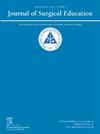Prediction of Basic Robotic Competence for Robotic Visceral Operations Using the O-Score within the “Robotic Curriculum for Young Surgeons” (RoCS)
IF 2.6
3区 医学
Q1 EDUCATION, SCIENTIFIC DISCIPLINES
引用次数: 0
Abstract
Introduction
Surgical residency programs lack structured assessments of robotic surgery. The validated O-Score is an assessment tool for tracking robotic operative proficiency consisting of 9 items on a 5 point Likert scale. Surgical autonomy is one comprehensive binary item. This study aimed to establish a benchmark for the number of procedures and the O-Score sum score to achieve surgical autonomy in robotic visceral procedures.
Material and Methods
This single-center prospective pilot cohort study assessed robotic procedures between 2020 and 2023. Bedside and console assistance performances were analyzed separately based on the O-Score and the calculated total numerical sum of the individual item values of the O-Score. Bedside assistance was conducted for upper gastrointestinal, hepatopancreatobiliary, and colorectal procedures, whereas console assistance referred to either one of the three areas. The study participants included inexperienced robotic surgeons who were evaluated by 2 robotic experts.
Results
In total, 273 procedures were included in this study. For 13 bedside assistants, 273 O-Score assessments were identified, and 62 O-Score assessments for six console assistants. Surgical autonomy was achieved in 50.9% for bedside assistance and in 11.3 % for assistance at the robotic console. Surgical autonomy was positively correlated with the O-Score sum for bedside (p = < 0.001) and console assistance (p = 0.004). The positive prediction of surgical autonomy for bedside (console) assistance ranged from 74% (60%) to 93% (100%), correlated with a range of the O-Score sum between 37 (37) and 40 (40) and a robotic caseload between 19 (17) and 33 (24) procedures.
Conclusions
A significant improvement in the basic robotic performance was observed. Benchmarks regarding number of cases and O-Score sum were established for bedside assistance regardless of the type of visceral robotic operation. Currently, data on console assistance are limited. Monitoring robotic operative skills and skill progression is feasible in daily routine using the O-Score and O-Score sum.
使用 "青年外科医生机器人课程"(RoCS)中的 O 评分预测机器人内脏手术的机器人基本能力
本文章由计算机程序翻译,如有差异,请以英文原文为准。
求助全文
约1分钟内获得全文
求助全文
来源期刊

Journal of Surgical Education
EDUCATION, SCIENTIFIC DISCIPLINES-SURGERY
CiteScore
5.60
自引率
10.30%
发文量
261
审稿时长
48 days
期刊介绍:
The Journal of Surgical Education (JSE) is dedicated to advancing the field of surgical education through original research. The journal publishes research articles in all surgical disciplines on topics relative to the education of surgical students, residents, and fellows, as well as practicing surgeons. Our readers look to JSE for timely, innovative research findings from the international surgical education community. As the official journal of the Association of Program Directors in Surgery (APDS), JSE publishes the proceedings of the annual APDS meeting held during Surgery Education Week.
 求助内容:
求助内容: 应助结果提醒方式:
应助结果提醒方式:


